« Features
An Interview with Antonis Pittas on the Occasion of His Book ‘Road to Victory.’
the nostalgia for the past is a stupid thing
we are always ready for new work this has been part of our history I weight 76 kilograms
something went very wrong here this would hot have been possible 10 years ago I felt I had to do something
someone is looking for you but I don’t have time to be angry this is what we are left with I wish you’d come back tomorrow
we’re ready to go home I tried not to show any emotion let the bordello burn a place we must remember to forget
he thinks we have nothing to hide we don’t sleep at night
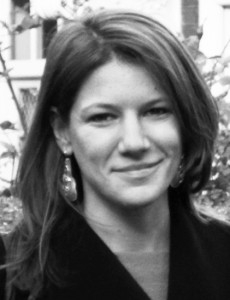 I read the above quote from an installation view of Antonis Pittas’ work Untitled (This is a historic opportunity for us), featured at the Van Abbemuseum as part of the artist’s residency in 2010 and reproduced in his recently published book Road to Victory. For each week of the residency, the artist applied a sentence to the interior wall of the space with a graphite stick, constituting a performative act. This is one of the artist’s characteristic ways of producing works by using writing with graphite on walls, floors, marbles and other surfaces, with the words and phrases taken from current news. Pittas’ work comprises of context-sensitive installations, often informed by architecture and art-historical references. He is also interested in the performative aspects of installations, their social dynamics as well as collective history.
I read the above quote from an installation view of Antonis Pittas’ work Untitled (This is a historic opportunity for us), featured at the Van Abbemuseum as part of the artist’s residency in 2010 and reproduced in his recently published book Road to Victory. For each week of the residency, the artist applied a sentence to the interior wall of the space with a graphite stick, constituting a performative act. This is one of the artist’s characteristic ways of producing works by using writing with graphite on walls, floors, marbles and other surfaces, with the words and phrases taken from current news. Pittas’ work comprises of context-sensitive installations, often informed by architecture and art-historical references. He is also interested in the performative aspects of installations, their social dynamics as well as collective history.
Pittas was born in Athens in 1973. He studied at the Athens School of Fine Arts, Piet Zwart Institute in Rotterdam Netherlands, and Sandberg Institute in Amsterdam, Netherlands, and has been an artist-in-residence at Bard College in Annandale, N.Y. Since 2000, he has lived and worked in Amsterdam, where he teaches at Gerrit Rietveld Academie. He is a regular guest teacher at Bergen Academy of Art and Design in Bergen, Norway, the KABK Fine Arts Department of the Royal Academy of Art in The Hague, and the Sandberg Institute in Amsterdam. He is also a visiting professor at University of Hildesheim in Hildesheim, Germany, and has been a guest teacher at many other academies across Europe and the United States.
The following interview has been made on the occasion of his recently published book Road to Victory.
By Daphne Vitali
Daphne Vitali - Antonis, your new book Road to Victory, designed by Project Projects and copublished by Mousse Publishing and Hordaland Kunstsenter, is a beautiful and extremely interesting book that presents many of your recent projects and includes a great collection of essays as well as archival and research material. This publication is indeed to be seen between an artist book and a source book and can be characterized by its performative character. Tell me how the idea of this book was born.
Antonis Pittas - About five years ago, I started my research on the Bauhaus and the Russian avant-garde against the backdrop of the current financial crisis. What I found interesting was that both movements have bloomed around moments of crisis and transformation, for good or for worse. They are interlinked with the promising developments of the Interbellum period, the Russian revolution as well as the Great Depression, being followed by an even darker period in time harshly determined by the rise of fascism. There is a lot of contradiction and tension in this historical period, including progressive social movements and forces of democratization alongside more destructive tendencies, sometimes even contained in the same historical entity. Both the Russian avant-garde as well as the Bauhaus were part of this bigger picture of which they were partly even responsible. Furthermore, Bauhaus points to the democratization of design and getting a wider public in touch with art, as it functioned as a catalyst for industrial reproducibility, while being aesthetically and initially also politically very cutting-edge, very challenging at the same time, and with a clear wish to change, overturn and even destroy the previous.
With maybe a sense of irony, I would say that we feel the post-post effects of this dynamic in our time, especially with regard to the unavoidable failure of the ‘new’ and ‘better,’ the repeated disillusionment that follows the fantasy of social progress. For me, it is important to revisit the moments when things turn-turn into something different that defeats the initial purpose by confronting with its violent ‘other.’ In other words: when things turn wrong. To do this, I adopt a formalistic approach, borrowing from the aesthetics and theory of both the German and Russian avant-gardes in order to capture what I call ‘public memory in the making.’ What I’m dealing with is the history and historiography of crises, the dependency of modern history on the very notion of the crisis.
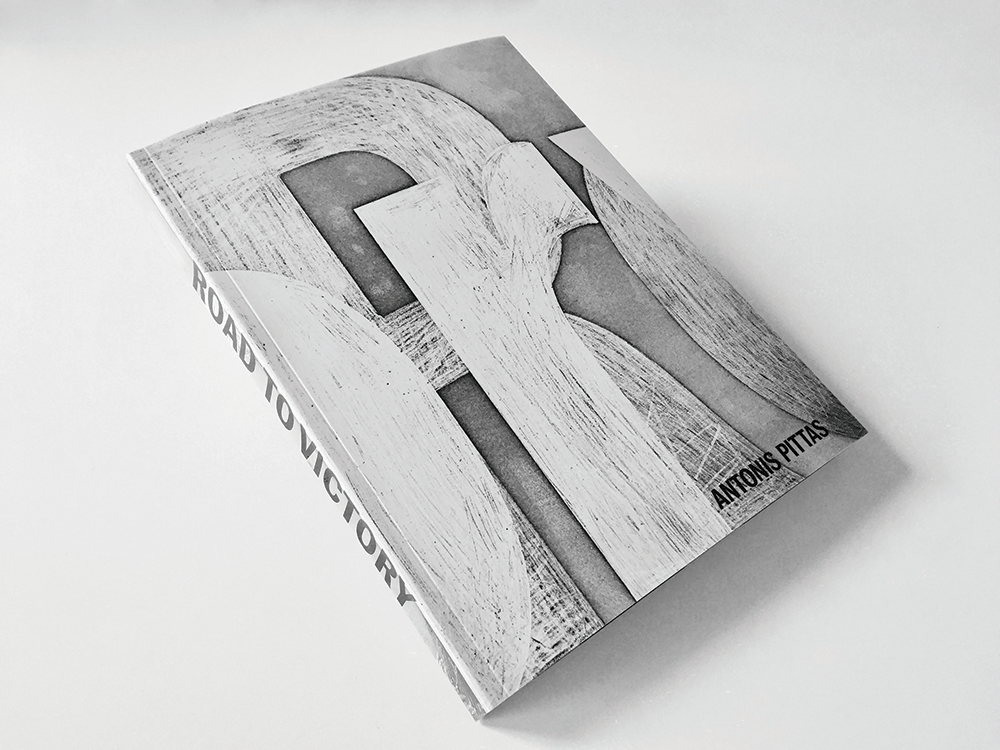
Cover page of Road to Victory Antonis Pittas. Bergen, Norway: Hordaland Kunstsenter and Milan: Mousse Publishing, 2017. Editors: Clare Butcher and Kris Dittel. Assistant Editor: Virág Szentkirályi. Contributing authors: Anthea Buys, Clare Butcher and Nikos Papastergiadis, Galit Eilat, Charles Esche, Boris Groys, Jelle Bouwhuis and Joram Kraaijeveld, Jennifer Steetskamp, Steven ten Thije, Natalie Hope O’Donnell and Rebecca Uchill. Graphic design: Project Projects.
The book is a very important document concerning this artistic trajectory, offering a context for further reflection but also functioning as an artwork in its own right, as a performative object. It basically constitutes as a stage in creating a series of works that I have also selected to be included in this book. It is by no means a complete overview or monograph in the stricter sense of the word, as it functions as a constellation of text and images that together evoke the historical interrelations I just mentioned, without putting a definite point at the end of the narrative. That’s where it’s performative, although there is also a literal, material layer to this performativity, starting with the layout and design and the fact that we used so-called rock paper for the cover, which gives it a cold feeling, like stone. A book is an object, and a limited edition, so yes, it also fits the criteria of a work of art or, if you will, a monument. And by reading the book, it becomes activated, pointing to monumentalization as a performative act.
D.V. - In the beginning of the book, we find a reproduction of the June 1942 volume of the bulletin of the Museum of Modern Art entitled “Road to Victory,” which accompanied the exhibition with the same title organized by the MoMA in New York in 1942 and was dealing with the politics of the American involvement in World War II, presenting, as the subtitle suggested, ‘a procession of photographs of the nation at war.’ A few years ago in the Stedelijk Museum Bureau Amsterdam (SMBA), you staged a situation which recalled the 1942 exhibition designed by Herbert Bayer and curated by Edward Steichen. Could you please tell me, how did you encounter this exhibition and this bulletin, and why did you choose to name your book after this historical propaganda exhibition? Has this exhibition influenced you both for its content and its form?
A.P. - I was looking into the work of Bauhaus designer Herbert Bayer when I encountered this exhibition project, which to me appears rather paradoxical. “Road to Victory” could be read as American nationalist propaganda; yet, it introduces the radically modern visual language of Bauhaus to the American context. It was actually the first non-art exhibition at MoMA. As an iconic exhibition and subject of study for many designers and artists afterward, it explores challenging strategies of display, approaching the exhibition in terms of a spatial choreography. The way the trajectory of the visitor constitutes a narrative in every exhibition is rendered explicit. Its complicity with patriotism and nationalism, and the question of growth and development it raises at a point in time when the world was at war, constitute, in my opinion, a very strong link with our own time. The title, “Road to Victory,” becomes ironic, maybe even sarcastic or cynical, applied to what happened after. Being a Greek artist in times of reoccurring crises, I could easily feel a sense of bitterness, but honestly, it’s more like hope. Because that’s in the title, too, I hope. I have these hopes for the future, something I don’t want to let go of as an artist, and there’s the simple beauty of the design as well.
D.V. - Again, in the beginning of your book, following the foreword, you included around 10 pages which are emphatically given to the word ‘IMPLEMENTATION,’ written with giant letters, referring directly to the famous words of Christine Lagarde and to the execution of the economic changes to be made and the plan of the troika for Greece. In this way, the reader of your book directly makes an association with the Greek crisis. Indeed, the contemporary situation of your native country is central to your artistic practice. Can you talk about this relation, and how do you as an artist relate to the contemporary sociopolitical reality in Greece through your work?
A.P. - Well, to be clear, I consider myself more of an observer than an activist. Being the observer can be a conscious artistic strategy. For me, it is closely linked to living abroad, keeping a relative distance to the events in my home country. It provides me with a certain detachment and, hence, emotional protection. Yet, at the same time, I feel that the economic crisis as it played out in Greece made me focus more, gave me responsibility as an artist. The majority of my works are somehow related to my visits to Greece, especially Athens. I obviously have emotional ties with the city, with my family, which cannot be denied. Being there also means that I can experience the crisis as a phenomenon and explore it as such. I don’t pretend to be a neutral observer. I do position myself, but more subtly than throwing stones or joining protests or anything like that. I position myself by showing transhistorical lines of development that can be interesting to the present. In the end, it’s not only about the crisis, it’s about various contexts in which the same rules apply. The geographical distance helps me to remain critical, also towards the Greek society, with all its flaws. So I never fell into the trap of feeling a victim, like many other Greeks.
Now, to the word ‘implementation,’ borrowed from Lagarde, it also refers to my own trajectory implementing the ideas of Herbert Bayer to the present situation, and more specifically, to the book. What struck me about Lagarde’s statement was the almost performative quality of that utterance, as if by repeating the word three times, the implementation itself was already done. That she repeated the word this many times was linked to the felt necessity of the implementation of economic reforms in Portugal, Spain and Greece, three countries struggling with debt. The performativity of the utterance at once evokes the holy three-Trinity-and various other symbolisms from the past. That’s why it also caught my attention.

Reproduction of the cover of MoMA New York bulletin entitled Road to Victory (June 1942), which accompanied the exhibition with the same title organized by the museum in 1942.
D.V. - For their interesting and insightful discussion concerning the economic consequences, Clare Butcher and Nikos Papastergiadis take as a starting point the Greek poem Waiting for the Barbarians by Greek 20th century poet Constantine P. Cavafy written in 1898. The poem depicts a day in an unnamed city-state where everything has come to a halt because the population is awaiting the arrival of the ‘barbarians,’ whom they plan to welcome. It is interesting to note that recently this poem has also been referred to both for its relation to contemporary politics and for the arts in Greece. Specifically, this was also the title chosen by the curators for the last Athens Biennale. How do you feel about this idea of Greece being a platform for discussing modern European colonialism?
A.P. - Well, who’s the barbarian in this case? Who is civilized? During the 20th century, and most acutely, through the financial crisis, the traditional relationship between Europe and Greece has been reversed. In that way, my book can easily function as a platform or point of departure to further investigates the issues-of economics, politics, identity-that underlie the complicated present relationship between Germany and Greece, to quote the obvious example. If you talk about colonialism, it’s not so much about the literal geographic sense of the word but rather about the way ideas are colonized. I mean, who is learning from whom? Interestingly, the historical exhibition “Road to Victory” made a similar movement by exporting and introducing modernity to the United States, which, by this very instance, claimed their superiority. Appropriation basically turns into an affirmation of power. This dynamic applies to so many historical periods: Think of the Enlightenment and the reactivation and imaginative appropriation of Greek architecture in German Classicism. Greece is always already an unattainable idea, a surface of projection serving particular social desires. The Greek ideal and the Greek reality, there’s a great mismatch. It is, in itself, an interesting paradox or polarity. The ideal is contained, but reality is always already failing.
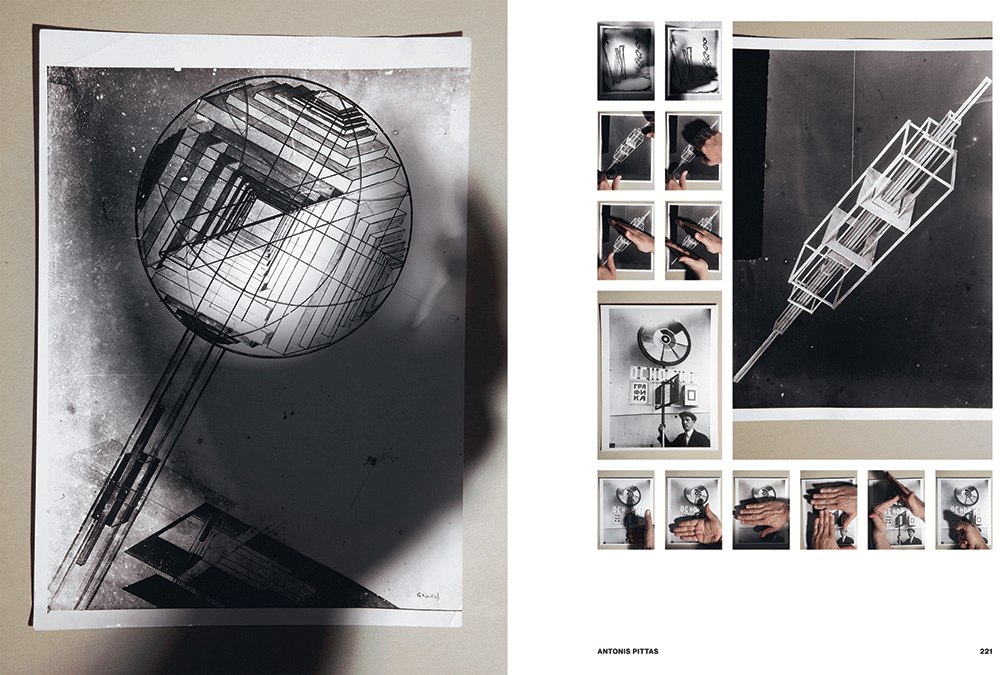
Antonis Pittas included in his book photographic material from his archive research on Gustav Klutsis and Lyubov Popova at the Costakis Collection as these artists played a crucial role in the development of propagandistic visual language. In these photographs Pittas explores the fine line between exploration and destruction in his handling of the artworks, as his hands are seen touching the unprotected surface of works by the two artists.
D.V. - You have worked several times with curator and museum director Charles Esche, who has written in the book the essay “Bodies, Gestures, Appearances” concerning materiality and physicality in the digital, post-human era. While, as he explains, the fabricated and the handmade are crucial elements in your practice, this is not the core importance of the work. Could you talk about your artistic practice from this materialistic perspective as well as from the physical point of view?
A.P. - A concept is nothing without materiality, and reproducible forms cannot do without craftsmanship to begin with. Looking to the past, the Bauhaus and the Russian avant-garde already exhibited this strange tension between industrial reproducibility and at times romanticized notion of craftsmanship. At the core of these movements, there is an indecisiveness concerning the role and status of the artist, epitomized in the image of the hand. The hand, more specifically the hand of the artist, is related to the act of creation, but also to power in terms of physical power. Both Bauhaus and the Russian avant-garde use the hand to provide the artist with a status as world-maker and engineer, maybe also out of fear that artists, in the new societies to come, would otherwise be rendered obsolete. Simultaneously, the hand has this intricate link with the idea of manual labor-labor that had become industrialized, standardized. Craft is personal; labor is collective. The artist’s hand positions the artist as craftsman in the middle of his modern peers, workers. Even the digital era hasn’t done away with the hand: digital technologies, especially the dispositive of the touch screen, and human touch are not thinkable without each other. For me, the hand functions as an important signifier of both destiny and responsibility, from the wish to seek future guidance to the very act of taking your life in your own hands. The hand is a powerful image.

Installation view from We will do as we have decided, 2013, at De Nederlandsche Bank, Amsterdam. Following the use of tear gas by police squads in cities like Istanbul and Cairo in 2011-2013. Pittas translated the shapes of the gas cans and other leftovers into sculptural objects, combining them with text fragments from news coverage.
D.V. - Moreover, in Esche’s essay, while discussing your work from the exhibition “Hold On” in the SMBA in Amsterdam, where soft-form copies of the artist’s hands in vibrant colors and mimicking the gestures of public figures and are presented scattered in the exhibition space, he mentions that, “These hands are also my hands, and those of the artist. They give and take, cradle and discipline, admonish and praise. Their power and potential lies in how they are disposed, and in what environments they are encountered.” Can you comment on this?
A.P. - How to turn a powerful image into an even more powerful one? Making the hands literally big, they become this thing that can hold you, which is tactile, real, there. And as the large hands can function as furniture, they evoke the interior design side of the Bauhaus movement and the impact it has had on today’s consumerist culture. In the collages of Klutsis, which I have researched more closely during my investigations, it is still the hands of Lenin and the unions that dominate the show. Eventually, it’s all about appropriation, translation, reiteration. I am fascinated by the way the meaning of a particular form can radically change over the course of history and through different contexts. This also counts for my own work. The most telling case of appropriation I‘ve personally encountered was when I participated in the Tallinn Photomonth, a contemporary art biennial in Estonia, where somebody else used my hands without my permission or the permission of the biennial as props in his own photo shooting-some queer TV personality, I learned later on.
D.V. - For your project Handle Them (2015), you were invited to take up the role of a curator and work with the collection of the Thessaloniki State Museum of Contemporary Art, which houses the Costakis Collection that features works from the Russian avant-garde. In the book, you have included photographic material from Gustav Klutsis’ and Lyubov Popova’s archive research. I am very interested in hearing from you more on how you worked for this project and what was the outcome.
A.P. - The reason that I wanted to focus on these two artists was the crucial role they played in the development of propagandistic visual language. For Popova, it was the theater, public space, the wish to reach a large public that fed her symbolism. Here, my heritage as a Greek artist plays up when I explore the dramaturgy of propaganda; how can you make a larger group of people believe what you are saying? I find this very fascinating. Klutsis, on the side, is all about participation, interaction, finding effective images and languages through slogans and magazine designs-less dramatic but easily as powerful. Popova and Klutsis constitute two different propagandistic strategies still valid today, as they are to convince, control, unify. This is why, for me, it was important to reactivate and contemporize them, creating new images in the present and making them available to the public. The images do not any longer function as a historical distant object-as usually in a collection or in a museum-but become relevant for the now. By looking at them, we learn about us.
D.V. - I would like to ask you one more question regarding your practice. In the beginning of Boris Groys’ essay “Under the Gaze of Theory,” reprinted in your book, the author states: “Theory was never so central for art as it is now. [...] I would suggest that today artists need a theory to explain what they are doing -not to others but to themselves.” How do you feel regarding this statement? Could you talk about your relation to theory as an artist?
A.P. - Well, basically, I consider theory as a practice, a particular kind of cognitive activity. Theory can be a vehicle or tool to guide art-related research, to understand the dynamics underlying the images that I combine or create. Theory is about synthesizing, connecting, making links. But even more so, theory-or more specifically, history and historiography-can function as material for an artwork. It’s more than just providing interpretation after the fact. It’s part of the process of creation. For me, making art depends on a complex mix of emotional, cognitive and intuitive processes. In my view, there is no ‘pure intuition’ before cognition or conceptual thinking. They are inseparable, and this is what I think makes my work contemporary. There’s no mind-body separation, mind and body go together, and the hand-my hand-is the interface between what I think and what I do.
Daphne Vitali is a Greek-Italian art historian and curator. Since 2006, she has worked as a curator at the National Museum of Contemporary Art in Athens, where she has organized numerous group and solo exhibitions of Greek and international artists. She has published essays on contemporary art in various publications and international art periodicals, including ARTPULSE, Kunstforum International and Mousse, and has authored many artists’ catalogues. She recently curated the exhibition “/Uncinematic George Drivas” at the Galleria Nazionale d’Arte Moderna e Contemporanea in Rome in 2017.


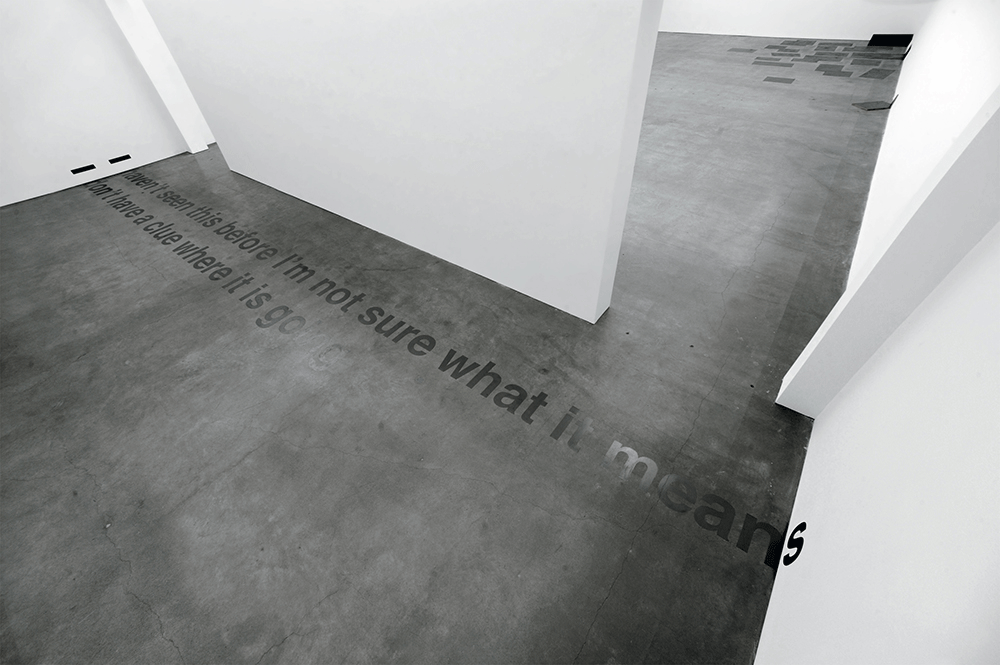

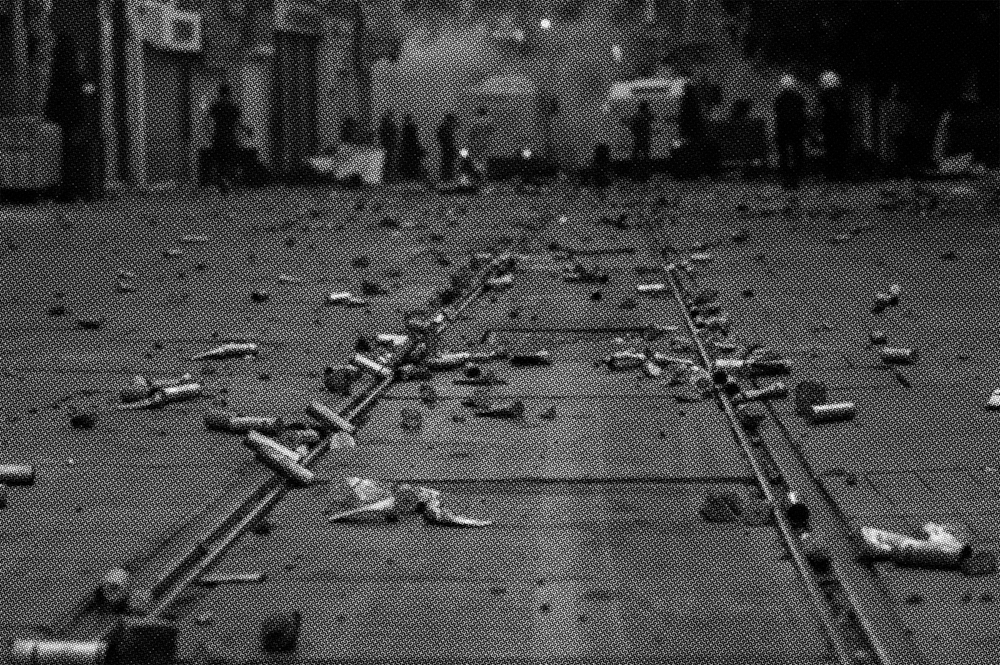


































Leave a Reply
You must be logged in to post a comment.